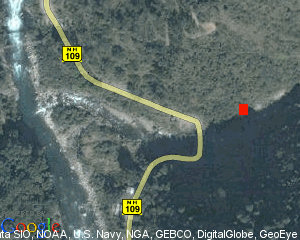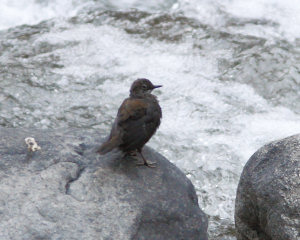 Kakdagad
(~1000m), 46 Kms before Gauri Kund (Kedarnath), Uttarakhand, India
on 4 July 2009. (Coor.: 30.490610, 79.086167).
Kakdagad
(~1000m), 46 Kms before Gauri Kund (Kedarnath), Uttarakhand, India
on 4 July 2009. (Coor.: 30.490610, 79.086167).
YS Negi and I.
"It's 5 PM, time for the Honeyguide."
"How far is it?"
"Just 300m away."
Construction of a bridge on the mouth of a narrow river (at best
a small tributary stream now, with scanty rains and all) which merges
with the main river Mandakini, was creating a commotion. However,
100m on we lost sight of the workers as we walked along the abundant
boulders down below to our left with water flowing by. The rock beehives were now visible on the other side of the river
at the same level, a steep hillside with a few intact and a few
broken bee combs abandoned by the wild bees.
The rock beehives were now visible on the other side of the river
at the same level, a steep hillside with a few intact and a few
broken bee combs abandoned by the wild bees.
Negi looked over the valley through his binoculars,
"Can't see the Honeyguide, let's wait for it."
"When were you here last?"
"Three days back; it's sure to come."
"There it is", he whispers in muted excitement, his enthusiasm as
fresh as someone on a lifer. We suddenly see a dark finch like bird
with a clear yellow rump circle the area and fly back towards the
cover of the jungle ahead. "It will come back, it likes to wait
in the nearby trees and then finally goes to the hive."
An hour passes by, and we see no sign of the Honeyguide. Nor of
any other bird, I think of the Cheer Pheasant, but on a local report,
higher elevations of Madmaheshwar may hold them. No sign of Kalij
either, which normally is barely happy far away from the din of
humans. Monal I knew I would find at Tunganath and one hardly expects
a Koklass at lower, shallower and disturbed forest.
 "It's getting dark now and I am afraid, we might not get a shot."
I sounded meditative if not altogether dispirited. "It's because
of these noisy Ashy Drongos that our bird is not coming near. I
can also see a Blue Whistling Thrush nest just two meters from the
combs." He finds a reason.
"It's getting dark now and I am afraid, we might not get a shot."
I sounded meditative if not altogether dispirited. "It's because
of these noisy Ashy Drongos that our bird is not coming near. I
can also see a Blue Whistling Thrush nest just two meters from the
combs." He finds a reason.
Stealthy Blue Whistling Thrush, not a raptor, yet a slayer of young
birds, not sparing even a large juvenile Long-billed Thrush. Once,
however, on a quiet morning, after a stormy night, I saw it whistle
by the Nainital Lake. It continued for a long time with its sweet
and melodious whistle.
Just then, our Honeyguide flew in and perched right next to the
Drongos on the other side. A casual look would not have revealed
the bird now resting quietly in the dark woods, the likeness of
the bird being much like the stem of its choice. The compact flash
cards of the camera worked overtime to record clicks of the bird,
which was nothing more than a speck.
After a while, the Honeyguide rose and at the same time, by chance,
a pair of quarrelling Ashy Drongos created a commotion which made
the  bird
divert its flight to a tree just meters away from me. Now I could
see the ruffled bird in breezy surroundings and magnified proximity,
much more clearly. The dark bird in the green umbrella of the trees,
the creepers, the mossy sheaths on the tree trunks; magical moments
held forever.
bird
divert its flight to a tree just meters away from me. Now I could
see the ruffled bird in breezy surroundings and magnified proximity,
much more clearly. The dark bird in the green umbrella of the trees,
the creepers, the mossy sheaths on the tree trunks; magical moments
held forever.
The bird playing hide-and-seek behind the swaying leaves threw a
lot of challenge to my camera. Shoot as you will and be overwhelmed
as much, but the expectation of a better shot never goes away. The
impassive but alert Honeyguide, secure in the knowledge of available
food, soon flew to a bee nest attached to the mossy reddish grey
rocks and remained hidden from view. After ten minutes or so, it
flew back to the jungle.
It soon was dark and I walked back in an unusually warm evening
in the Himalaya. - DD
Click here to go back
to previous page

